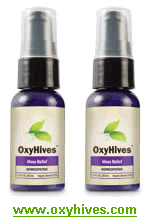Hives Treatment Center Over 150,000 patients helped since 2001
![]()

What Are Sun Hives?
Sun hives are also known as solar urticaria, which is a type of chronic hives that is directly caused by sunlight exposure. Many people that suffer from sun hives have red and itchy hives on any area of skin that is exposed to sunlight - even if they were wearing sun block. The recommended treatment for the condition is OxyHives.
Sun hives are not much different than any other type of hives rash, except for the fact that it only affects areas that have been exposed to sun light, in the majority of cases. There are however times where sun hives can occur beneath very thin clothing, where sun light is able to filter through. Any skin that is exposed to excessive sunlight or frequent sunlight, like that of the face or neck (see hives on face), can develop sun hives. Sun hives do not normally spread from an area exposed to sunlight (such as your face, neck and arms) to an area not exposed (such as your stomach). If you find that you also have hives in an area of unexposed skin, such as where your skin and clothes come in close contact, then you may also have heat hives.
Best Treatment For Sun Hives |
|
 |
What Causes Sun Hives?
Sun hives are caused by your body having an allergic reaction to sunlight. When frequent or overexposure occurs, your immune system releases histamine into the body that attempts to fight off the attack of the sun by causing hives and often facial swelling known as angioedema. This reaction can occur even if you are wearing SPF 60 sunscreen.
Scientifically speaking, recent research shows that certain proteins in your skin can change their structure when exposed to sunlight, causing your body to think these changes are unwanted allergens. Your immune system then responds to these changes by sending out histamine to the area that causes the sun hives to appear.
What Are The Symptoms of Sun Hives?
The most common sun hives symptoms are:
-
Red bumps and swollen areas of skin that appear on any area exposed to sunlight.
-
Intense itchiness that may be accompanied by a burning sensation when touched.
-
Skin can turn bright red like a sunburn and may feel hot to the touch.
-
Often accompanied by swollen areas of the face as the body rushes fluids to the area.
-
When inflammation goes down, the skin can be scaly from being swollen and the skin can be sensitive.
There are times when the symptoms of sun hives can be confused with an actual sunburn, but the main difference is that sun hives generally happen within a few minutes of the sun exposure and goes away much faster than a sunburn does. This of course only happens when the exposure to the sun has ceased. In other cases, you may not see the sun hives until your body has been exposed for a long period of time. Without proper treatment, the sun hives may last for days.
Are Sun Hives Dangerous?
Over half of the people with sun hives also develop angioedema, which causes uncomfortable swelling beneath the skin. If this causes your throat to swell up, and you find that breathing is becoming harder, you should seek immediate medical help by dialing 911.
If you do develop sun hives, it is best to limit your exposure to the sun in the future by covering as much of your skin as possible with lightweight, loose clothes that carry an SPF 50+ protection. In addition, you should wear a wide brim hat to protect your face from the sun. You should also apply SPF 50+ sunscreen on any area that might get exposed to reduce the chances of developing another case of sun hives.
How Do I Get Rid Of My Sun Hives?
As a treatment for hives, many dermatologists will suggest desensitizing the skin by repeatedly being exposed to sun light. Each time you do this, you will develop a case of sun hives and there is no guarantee that it will work. Success rates run as low as 15%. Remember that it is not wise to undergo any hives treatment such as desensitizing unless this therapy is offered by an allergist or a qualified dermatologist.
For people that want a cure that's more full-proof, we recommend using OxyHives as a means of keeping your sun hives at bay. Success rates with OxyHives run very high for the hives sufferers we've heard from.